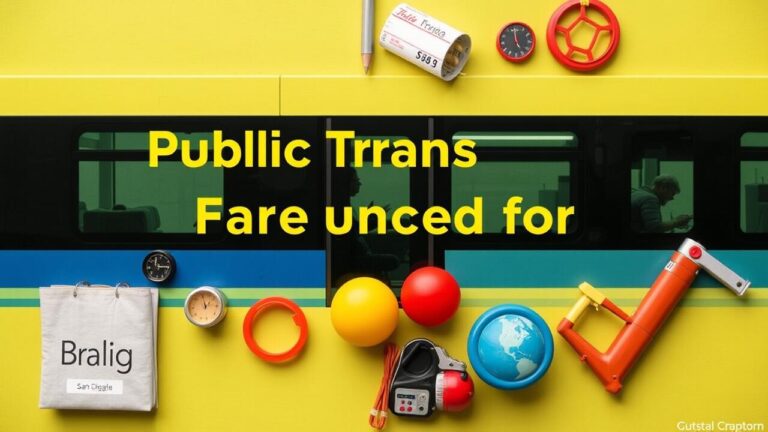San Diego Implements Smart Traffic Management System to Optimize Road Efficiency
Table Of Contents
San Diego Implements Smart Traffic Management System To Optimize Road Efficiency | San Diego Implements Smart Traffic Management System to Enhance Road Efficiency
Key Takeaways
- San Diego adopts an intelligent transportation system to enhance roadway productivity and outlines its traffic control approach.
- Innovations supporting the intelligent transportation system are discussed.
- Advantages of the intelligent transportation system are highlighted.
- The execution procedure in San Diego is detailed.
- Examples of effective transportation control systems are presented.
San Diego Implements Smart Traffic Management System To Optimize Road Efficiency | Overview of San Diego’s Traffic Management Strategy
The introduction of an innovative traffic management system marks a significant advancement for San Diego. This initiative aims to enhance road efficiency by optimizing traffic flow through advanced technologies. By utilizing smart traffic signals and real-time data collection, the system can adaptively manage vehicle movement across the Freeway and local roads. As a result, route planning becomes more efficient, leading to reduced congestion and shorter travel times. As San Diego implements this smart traffic management system to optimize road efficiency, the focus remains on creating a safer, more organized environment for all road users.
San Diego Implements Smart Traffic Management System to Optimize Road Efficiency | Goals for Road Efficiency
San Diego Implements Smart Traffic Management System to Optimize Road Efficiency aims to create a seamless flow of traffic across the city. The strategy focuses on improving signalized intersections and optimizing parking availability. By employing advanced technology, the system will analyze real-time data to enhance vehicle movement and reduce delays at critical junctions. This initiative also includes the implementation of highway advisory radio to provide travelers with timely updates on road conditions and traffic patterns.
Improving network performance is a key goal of the initiative. The Smart Traffic Management System will facilitate better coordination between various intersections, minimizing congestion and enhancing overall efficiency. By integrating data from multiple sources, the system seeks to create an interconnected approach to traffic management. With these enhancements, San Diego Implements Smart Traffic Management System to Optimize Road Efficiency will provide a safer and more accessible environment for all road users.
Key Features of the Smart Traffic Management System
The San Diego Implements Smart Traffic Management System to Optimize Road Efficiency incorporates advanced surveillance equipment and sensors to gather real-time data on traffic conditions. This technology enables efficient demand management by analyzing traffic patterns, which helps inform dispatch systems for better routing and response times. The integration of these features creates a robust network capable of adapting to the dynamic nature of urban transportation.
Another key aspect of this system is its ability to facilitate communication between various infrastructure components. By utilizing a network that connects traffic signals, cameras, and control centers, San Diego Creates a comprehensive view of the transportation landscape. This interconnectedness allows for timely adjustments to traffic flow, ultimately enhancing road efficiency across the city. San Diego Implements Smart Traffic Management System to Optimize Road Efficiency emphasizes the importance of technology in addressing the challenges of modern urban transport.
Technology Behind the Smart Traffic Management System
The integration of advanced technology is central to the effectiveness of San Diego’s traffic management strategy. San Diego Implements Smart Traffic Management System to Optimize Road Efficiency by utilizing cutting-edge tools designed for real-time traffic monitoring and analytics. This system incorporates advanced sensors and data collection methods that allow traffic management centers to make informed traffic management decisions. By analyzing traffic patterns, the system enhances traffic control strategies, leading to more efficient travel routes and reduced congestion. Through these special traffic management solutions, San Diego aims to create a safer and more efficient environment for both drivers and pedestrians.
Advanced Sensors and Data Collection
The integration of advanced sensors is a cornerstone of San Diego’s efforts as the city implements a Smart Traffic Management System to optimize road efficiency. These sensors provide crucial data on vehicle flow and traffic density, enhancing the traffic management resources available to the traffic management center. By capturing real-time information, the system enables a single traffic management approach that streamlines traffic operations throughout the region.
Coupled with sophisticated data collection methods, the system also facilitates regional traffic management strategies. This innovative shift in the traffic management field allows for precise traffic control measures, effectively addressing congestion and improving overall road safety. San Diego’s commitment to using cutting-edge technology underscores its goal to enhance efficiency as it implements the Smart Traffic Management System to optimize road efficiency.
Realtime Traffic Monitoring and Analytics
San Diego Implements Smart Traffic Management System to Optimize Road Efficiency through sophisticated real-time traffic monitoring and analytics. This system measures traffic network performance, allowing traffic managers to assess current conditions and make data-driven decisions. Advanced controls traffic sensors are strategically placed throughout the city to capture vital information about vehicle flow. By analyzing this data, traffic managers can identify patterns and variations in traffic impacts, leading to effective traffic flow optimization strategies.
Real-time monitoring allows for immediate responses to changing traffic conditions. For instance, suburban traffic control can benefit from instant updates on congestion levels or accidents, enabling swift rerouting and adjustments to signal timings. The ability to dynamically control traffic not only enhances the overall efficiency of the road system but also improves driver experiences across San Diego. With these capabilities, San Diego Implements Smart Traffic Management System to Optimize Road Efficiency effectively addresses modern urban mobility challenges.
- Enhanced road efficiency through data-driven decisions
- Immediate response to changing traffic conditions
- Reduction of congestion through real-time updates
- Improved driver experience due to optimized traffic flow
- Increased safety through faster response to accidents
- Better air quality as a result of reduced idling and congestion
- Long-term planning made more effective with traffic pattern analysis
Benefits of the Smart Traffic Management System
The implementation of a Smart Traffic Management System in San Diego aims to significantly enhance road efficiency. By leveraging advanced traffic data, the system can accurately measure traffic network performance and predict future traffic conditions. This capability allows for more effective management of work zone traffic, ensuring minimum traffic impact during construction and maintenance activities. Improved freeway operations are another critical benefit, as the system dynamically adjusts traffic signals and flow patterns. With San Diego’s focus on optimizing road efficiency, these advancements promise to create a more responsive and efficient traffic network for all drivers and pedestrians.
Reducing Congestion and Travel Times
San Diego Implements Smart Traffic Management System to Optimize Road Efficiency focuses on reducing congestion through advanced traffic surveillance equipment. The system continually monitors traffic flow and identifies incidents in real time. This approach allows traffic operations personnel to respond swiftly to disruptions, ensuring that traffic operators can disseminate current traffic information effectively. With improved coordination among roadway equipment, the city aims to streamline traffic movement, resulting in shorter travel times for commuters.
Efficient traffic management is essential for urban areas facing increasing vehicle volumes. By leveraging the capabilities of the Smart Traffic Management System, San Diego Implements Smart Traffic Management System to Optimize Road Efficiency enhances the overall driving experience. Strategic adjustments to signal timings and real-time routing information help mitigate delays caused by traffic incidents. This dynamic approach not only boosts roadway efficiency but also contributes to a smoother flow of vehicles throughout the city.
Enhancing Safety for Drivers and Pedestrians
The San Diego Implements Smart Traffic Management System to Optimize Road Efficiency focuses heavily on enhancing safety for both drivers and pedestrians. Advanced road sensors and vehicle roadside equipment continuously monitor traffic conditions. This technology enables real-time sharing of traffic information with service vehicles, which can then relay updates to drivers. Improved future route planning allows for better decision-making, reducing the chances of accidents and creating a safer road network.
Enhanced safety measures rely on the integration of TMC roadway equipment that can adjust traffic signals based on real-time data. This responsiveness mitigates potential hazards by ensuring that pedestrians can cross streets safely while maintaining efficient flow for vehicles. Overall, San Diego Implements Smart Traffic Management System to Optimize Road Efficiency not only aims to reduce congestion but also prioritizes the safety of all road users through innovative technology and strategic planning.
- Improved traffic signal timing to accommodate pedestrian crossing needs
- Implementation of dedicated pedestrian lanes to enhance safety
- Increased visibility with better street lighting and signage
- Regular maintenance and updates of road infrastructure to prevent hazards
- Integration of pedestrian detection technology at crosswalks
- Collaboration with local law enforcement to monitor and enforce traffic regulations
- Community outreach programs to educate drivers and pedestrians about road safety
Implementation Process in San Diego
The deployment of the smart traffic management system in San Diego involves several carefully planned phases. Initial efforts focus on integrating advanced lane control strategies to enhance traffic flow and reduce congestion. The implementation also includes roadway treatment systems that optimize conditions for transit operations and ensure smoother driving experiences. Ongoing maintenance systems are established to monitor the system’s effectiveness and address any issues promptly, including solutions for wrong-way driving incidents. This comprehensive approach supports San Diego’s goals as it strives to optimize road efficiency and improve overall urban mobility. Through effective coordination, San Diego Implements Smart Traffic Management System to Optimize Road Efficiency, setting a benchmark for future advancements in urban traffic management.
Phases of Deployment
The deployment of the system in San Diego involves multiple phases aimed at ensuring a smooth transition. Initial steps include assessing existing traffic patterns and integrating advanced sensors to gather data on transportation demand across various routes. This analysis supports wide area optimization, enhancing the efficiency of response vehicles and maintenance activities within the city’s transportation facilities.
Subsequent phases focus on the implementation of real-time monitoring capabilities, allowing for immediate adjustments based on traffic conditions. By targeting key roadways, the system aims to alleviate congestion and improve the overall efficiency of the route network. San Diego Implements Smart Traffic Management System to Optimize Road Efficiency reflects a commitment to modernizing infrastructure and enhancing the overall transportation experience for all users.
Community Involvement and Feedback
Engaging the community is essential for the success of the San Diego Implements Smart Traffic Management System to Optimize Road Efficiency. Local residents and stakeholders are encouraged to share their experiences and suggested transit strategies, ensuring that the system reflects real-world needs. Feedback loops allow the city to gather insights on how drivers interact with current traffic patterns and surface potential adjustments. This collaborative approach helps forecast road conditions and enhances the effectiveness of roadside control plans.
The city has established a construction management center to facilitate communication between planners and the community. This center not only serves as a hub for information but also seeks input on planned control strategies from residents. By integrating public feedback, San Diego aims to fine-tune its traffic systems, ultimately enhancing efficiency and safety for all road users. The commitment to community involvement embodies the core principle behind the San Diego Implements Smart Traffic Management System to Optimize Road Efficiency.
| Feedback Type | Details | Implementation Status |
|---|---|---|
| Improved Traffic Signal Timing | Residents suggested adjustments for peak traffic hours. | Implemented |
| Clearer Road Signage | Community feedback indicated confusion at major intersections. | In Progress |
| Dedicated Bike Lanes | Concerns raised about cyclist safety. | Proposed |
| Public Transit Improvements | Suggestions for more frequent bus services. | Feedback Under Review |
Case Studies of Successful Traffic Management Systems
Successful traffic management systems in various cities offer valuable insights that can enhance San Diego’s approach. By studying these models, San Diego can implement features such as real-time transportation information, which helps drivers navigate efficiently and reduces unnecessary delays. Strategies like truck restrictions and wrong-way driving countermeasures have proven effective in minimizing disruptions and increasing safety at many intersections. Evaluating network performance through data analytics can aid in emissions management, ensuring the city optimizes its traffic flow while contributing positively to environmental goals. As San Diego Implements Smart Traffic Management System to Optimize Road Efficiency, lessons from other cities provide a foundation for developing adaptive solutions that address local challenges.
Lessons Learned from Other Cities
Cities that have successfully implemented smart traffic management systems offer invaluable insights for San Diego. Lessons in signal control have shown that adaptive technologies can minimize congestion by responding to real-time traffic conditions. Proper maintenance of these systems is crucial to ensuring their effectiveness. Cities that prioritize regular updates and technological enhancements see improved transit flow and overall efficiency, guiding San Diego in its efforts to optimize road efficiency.
Best practices from other metropolitan areas highlight the importance of integrating in-vehicle technology for drivers. Such systems provide real-time updates that can alter driving behavior, helping reduce travel times. Cities with robust community feedback mechanisms have also benefited from understanding driver needs and preferences. These combined experiences can assist San Diego as it fine-tunes its plans and systems for a smarter, safer traffic landscape.
Conclusion
San Diego Implements Smart Traffic Management System to Optimize Road Efficiency marks a significant step in urban planning and infrastructure development. The system effectively controls and manages traffic flow, enhancing overall operations across the city. By utilizing advanced technology, this approach allows for the remote monitoring of traffic conditions in various zones. Such strategic initiatives not only streamline transportation but also contribute to a safer driving environment. The comprehensive integration of these systems showcases San Diego’s commitment to embracing innovation for improved road efficiency.
FAQS
How does the smart traffic management system in San Diego disseminate traffic information and share real-time transportation information with drivers?
The smart traffic management system in San Diego disseminates traffic information by using advanced technology that remotely monitors traffic conditions and vehicles on the road. This system collects data to evaluate network performance and adjust signals for improved flow. Additionally, it provides real-time transportation information to in-vehicle systems, helping to manage overall transportation demand effectively.
How does the smart traffic management system in San Diego evaluate network performance and enhance the in-vehicle experience for drivers using real-time transportation information?
The smart traffic management system in San Diego utilizes advanced technologies to evaluate network performance, enabling it to share traffic information efficiently. By monitoring road conditions and traffic flow, the system provides real-time transportation information that enhances the in-vehicle experience for drivers.
How does the smart traffic management system in San Diego contribute to overall network performance evaluation while providing real-time transportation information for the benefit of drivers in their in-vehicle experience?
The smart traffic management system in San Diego plays a crucial role in network performance evaluation by utilizing advanced analytics to monitor traffic patterns and conditions. By offering real-time transportation information, the system facilitates a smoother in-vehicle experience for drivers, allowing them to make informed decisions and reduce congestion on the roads.
In what ways does San Diego’s smart traffic management system utilize real-time transportation information to improve the in-vehicle experience for drivers?
San Diego’s smart traffic management system leverages real-time transportation information to enhance the in-vehicle experience for drivers by providing timely updates on traffic conditions, suggesting optimal routes to avoid congestion, and alerting drivers to potential delays. This integration of real-time data ensures that drivers receive the most accurate and relevant information while on the road, ultimately making their travel more efficient and enjoyable.
How does San Diego’s smart traffic management system impact the efficiency of road traffic using real-time transportation information for drivers?
The smart traffic management system in San Diego significantly enhances road efficiency by utilizing real-time transportation information. This system collects and analyzes data on traffic conditions, which aids in optimizing traffic flow. Consequently, drivers benefit from an improved in-vehicle experience as they receive timely updates and routing suggestions based on current traffic situations.
What are the benefits of incorporating real-time transportation information into the in-vehicle experience for drivers in San Diego’s smart traffic management system?
The incorporation of real-time transportation information significantly enhances the in-vehicle experience for drivers in San Diego. By providing live updates on traffic conditions, detours, and travel times, drivers can make informed decisions that optimize their routes. This leads to reduced congestion, improved safety, and a more efficient overall transportation network, all of which are key benefits of the smart traffic management system.
What role does real-time transportation information play in enhancing the in-vehicle experience for drivers using San Diego’s smart traffic management system?
Real-time transportation information is crucial for optimizing the in-vehicle experience for drivers using San Diego’s smart traffic management system. By providing timely updates on traffic conditions, road closures, and other relevant data, drivers can make informed decisions about their routes. This not only improves their overall driving experience but also contributes to more efficient road traffic management by reducing congestion and travel time.
What are the various applications of real-time transportation information in enhancing the in-vehicle experience for drivers within San Diego’s smart traffic management system?
The smart traffic management system in San Diego uses real-time transportation information to improve the in-vehicle experience for drivers by providing timely updates on traffic conditions, optimizing routing, and enhancing navigation systems. This integration ensures that drivers receive accurate data that can help them make informed decisions on the road, ultimately leading to smoother travel and improved overall efficiency in their driving experience.
How does San Diego’s smart traffic management system ensure that real-time transportation information is effectively utilized for improving the in-vehicle experience for drivers?
San Diego’s smart traffic management system ensures that real-time transportation information is effectively utilized by integrating advanced technology that collects and analyzes traffic conditions, making this information readily available to enhance the in-vehicle experience for drivers. By providing timely updates on traffic patterns, congestion, and alternative routes, the system significantly improves the in-vehicle navigation and driving experience, allowing drivers to make informed decisions while on the road.
How can drivers effectively access real-time transportation information that enhances their in-vehicle experience in San Diego?
Drivers in San Diego can effectively access real-time transportation information through various apps and systems integrated with the smart traffic management system, which significantly enhances their in-vehicle experience by providing timely updates on traffic conditions, rerouting options, and other relevant data to ensure smoother and more efficient travel.







